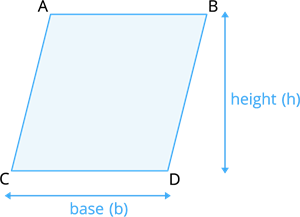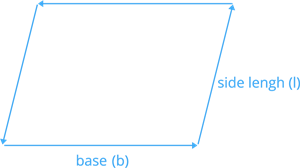
PUMPA - SMART LEARNING
எங்கள் ஆசிரியர்களுடன் 1-ஆன்-1 ஆலோசனை நேரத்தைப் பெறுங்கள். டாப்பர் ஆவதற்கு நாங்கள் பயிற்சி அளிப்போம்
Book Free DemoTo calculate the area of a parallelogram, multiply the base times '\(b\)' the height '\(h\)'.

Area of parallelogram \(A =\) \(b × h\) \(square\) \(units\).
Example:
A parallelogram has a base of \(6 m\) and \(3 m\) height, what is its area?
Let the base \(b= 6m\) and the height \(h= 3m\).
Area \(A = b × h = 6m × 3m =18m²\).
To calculate the base of the parallelogram, divide area '\(A\)' by height '\(h\)'.
Base of parallelogram \(b = A/h\) unit.
Example:
A parallelogram has an area of \(64 m²\) and its height \(4 m\), what is its base?
Let the area \(A= 64m²\) and the height \(h= 4m\).
Base \(=\) .
To calculate the height of the parallelogram, divide area '\(A\)' by base '\(b\)'.
Height of parallelogram \(h = A/b\) unit.
Example:
A parallelogram has an area of \(64 m²\) and \(16 m\) base, what is its height?
Let the area \(A= 64m²\) and the height \(h= 16m\).
Height \(=\) .
Where '\(A\)' is denoted as area, '\(b\)' is denoted as the base and '\(h\)' is denoted as the height.
To calculate the perimeter of a parallelogram, multiply \(2\) times the (base \(+\) side length).

Perimeter of parallelogram \(P = 2 (b + l)\).
Where '\(b\)' is denoted as the base, and '\(l\)' is denoted as the side length.
Example:
A parallelogram has a base of \(5 m\) and \(3 m\) length, what is its perimeter?
Here the base \(b= 5m\) and the side length \(l= 3m\).
Perimeter \(=2(b + l)\)
\(=2(5+3)\)
\(=2(8)\)
\(=16m\).